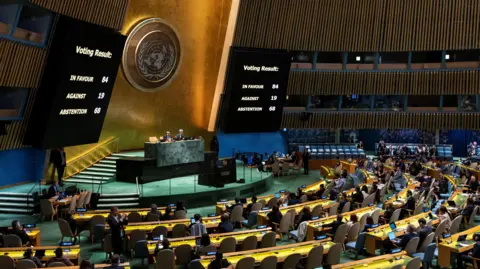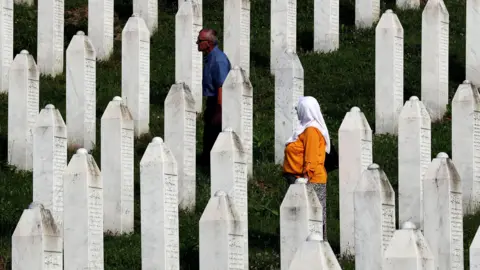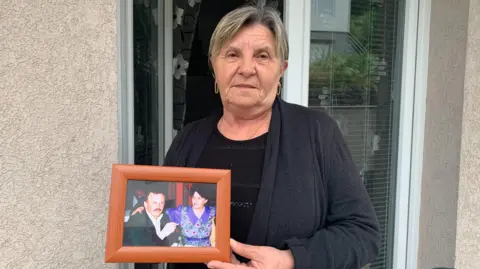Through Natasa Andjelkovic, bbc information serbian
Through grujica andrić, bbc information serbian
 BBC
BBCEvery July, Sbrija Hajdarević returns to Srebrenica to talk from the graves of her husband and father.
They were among approximately 8,000 Bosniak Muslim men and boys killed by Serb forces in 1995.
The 67-year-old now lives hundreds of miles away in Australia, but the annual shuttle is a package for her.
This year is even more poignant, like the first year, while July 11 will be marked by a world life of reflected image and commemoration, followed by a Decision of the General Meeting of the United Nations in May.
The Srebrenica massacre, recognized by the United Nations as genocide, was the stunning climax of the war in Bosnia – a war that erupted after the dissolution of Yugoslavia in the early 1990s.
In Bosnia, which was one of the most developed countries after partition, three communities were at war – on the one hand, the Bosnian Serbs, supported by Serbia, and on the other, the Bosniaks and Croats.
 reuters
reutersAbout 40,000 Bosniak Muslims lived in Srebrenica. Many were forced to flee the Bosnian Serb campaign of ethnic cleansing during the 1992–95 war.
The city was declared a United Nations Security Area in 1993 and world peacekeepers were charged with protecting it from any attacks.
However, in July 1995, Bosnian Serb forces – led by military commander Ratko Mladic – stormed the city and defeated the peacekeepers.
The Serb army rounded up the men and boys of the town, most of whom were never seen alive again.
They either died in large numbers or were massacred as they attempted to cross the wooded hills around Srebrenica.
 Fehim Demir/EPA-EFE/REX/Hotto via Shutterstock
Fehim Demir/EPA-EFE/REX/Hotto via ShutterstockThe brutal killing of approximately 8,000 men and boys was described as Europe’s worst mass atrocity since Global War II. The survivors of the population of about 1,000 are still missing.
Ratko Mladic was sentenced to life in prison for war crimes, including genocide, and about 50 Bosnian Serbs were also convicted.
The UN’s new response, designating July 11 as a reflective image of world life and a commemoration of the Srebrenica massacre, condemned any denial of genocide and the glorification of war criminals.
However, most Bosnian Serbs, in addition to the majority of Serbia’s population, have repeatedly denied that what happened in Srebrenica in 1995 was genocide.
Sbarija re-emphasised claims that the Srebrenica killings were not concentrated.
“What happened should be known, instead of spreading all these lies,” she says. “My soul hurts.”
Some Bosniak families have been waiting a long time for their family members to be comforted, as the ID process is long and difficult.
Sabarija was able to bury her husband’s skull – a frame section that was dug up.
Her father’s remains have never been found, although she knows he was murdered near their home in Srebrenica because her mother witnessed the murder.
Six months after her father was murdered, her mother also died – “from grief,” Sabarija says, fighting back tears.
Many victims of the Srebrenica genocide are buried within the Potocari Cemetery. Thousands of simple white graves are dotted with boards in a field on the slope of a hill.

Berija Delić also lost her husband in the massacre. His surviving remains were found only a decade later, and he was buried in 2010.
At the height of the year, Berija decided to return from Malta to Srebrenica, where he sought safe haven from the war.
His son, a Muslim, married a Serb Orthodox girl who “loves my baklava,” he says of the sweet dish he makes.
Before the war of the 1990s, Srebrenica was a largely Bosniak Muslim city.
Now, the vast majority of the nation is Serb; One of the important citizens throughout the war were the soldiers.
“Even now you see someone walking around the city, and you know he has killed (Bosniaks) – but you remain silent, you can’t deal with him,” Berija says.
After the war, Bosnia divided into two entities – Republika Srpska and Bosnia-Herzegovina. Srebrenica is in Republika Srpska.
In the post-war years, the Bosniak nation declined and the Serb nation grew, although they now have one disorder in common – unemployment.
“There are no problems here between Serbs and Bosniaks, the tension is brought in by people from outside,” says Slaviša Petrovic, a 37-year-old vintage Serb who runs the local tourist administrative centre.
However he says the city wants jobs to attract the population.
Slavisa says nothing else has been revised in the new UN response to the genocide.
“People are now leaving Srebrenica just as they were leaving before it (the adoption of the resolution). There are no jobs, like there weren’t before.”
There are signs of decline within the city. A once extensive country spa and a former luxurious lodge have been closed, having fallen into disrepair for many years. Their partitions are lined with frescoes.

Roads in neighboring villages, where farmers once lived with healthy cattle, are filled with weeds.
Many local properties are still in ruins. A mosque and a Christian conservatory sit on a hill overlooking the city, its wartime wounds unhealed.
Serb and Bosniak children visit local kindergartens and schools together, and photographs of the ancient week are proudly displayed in a society park in the town centre.
However it is likely that children will soon stop taking steps in the right direction.
Slavisa is unhappy with the fact that the locals are leaving the city and congregating. “It feels like they’re leaving my house,” he says.

Only three of his classmates are still living in Srebrenica. The rest have gone elsewhere.
He, alternatively, is motivated to persevere.
But he also believes that his four-year-old daughter will not feel the same way when she grows up.
Discover more from news2source
Subscribe to get the latest posts sent to your email.





